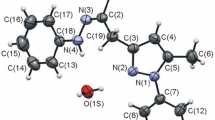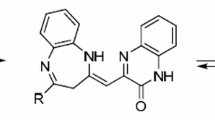Abstract
Catalytic hydrogenation of 3.6-dialkyl-1-phenyl-6-phenylazo-1.4.5.6-tetrahydropyridazines2 a-e gives crystalline bisphenylhydrazones of 1.4-diketones4 a-e; in solution,4 exists as a mixture of geometrical isomers due to the two phenylhydrazone functions. Reaction of2 a-f with H2NOH yields the dioximes of 1.4-diketones5 a-f. On acid hydrolysis of2, the 6-phenylazo substituent undergoes some reactions and yields products typical of the intermediate “zwitterionic” phenyldiazene. Thus, the tetrahydropyridazine part of2 d yields 1-anilino-2.5-diisopropyl-pyrrole (9), that of2 e gives 2.2.7.7-tetramethyl-3.6-octanedione monophenylhydrazone (10) which undergoes ready oxidation to 3.6-di-t-butyl-6-phenylazo-1.2-dioxan-3-ol (12).
Similar content being viewed by others
Literatur
G. J. Karabatsos, R. A. Taller undF. M. Vane, J. Amer. Chem. Soc.85, 2326 (1963);G. J. Karabatsos undR. A. Taller, J. Amer. Chem. Soc.85, 3624 (1963).
E. Lustig, J. Phys. Chem.65, 491 (1961).
C. Paal, Ber. dtsch. chem. Ges.18, 58 (1885).
K. Heß undF. Wissing, Ber. dtsch. chem. Ges.47, 1416 (1914);
E. E. Blaise, C. r. hebdomad. Sé. Acad. Sci.158, 1686 (1914).
K. Bowden, I. M. Heilbron, E. R. H. Jones undB. C. L. Weedon, J. Chem. Soc.1946, 39.
A. Spassoff, Bull. Soc. Chim. [5],4, 1658 (1937),
L. F. Deemer, L. Lutwak undF. M. Strong, J. Amer. Chem. Soc.70, 154 (1948).
E. Wahlberg, Ber. dtsch. chem. Ges.65, 1857 (1932).
J. Schantl, Mh. Chem.101, 1339 (1970).
A. J. Bellamy undR. D. Guthrie, J. Chem. Soc.1965, 2788.
J. Schantl, Mh. Chem. (im Druck).
C. Liebermann, Ber. dtsch. chem. Ges.7, 247, 806, 1098 (1874);
F. Feigl undV. Anger, Spot Tests in Organic Analysis, S. 290. Amsterdam: Elsevier, 1966.
Ref., S. 300..
M. S. Kharasch, H. C. McBay undW. H. Urry, J. Amer. Chem. Soc.70, 1269 (1948).
Author information
Authors and Affiliations
Additional information
Oxidationsprodukte von Arylhydrazon-Verbindungen, 9. Mitt. (8. Mitt.1).
1J. Schantl, Mh. Chem.105, 220 (1974).
Rights and permissions
About this article
Cite this article
Schantl, J. 3,6-Dialkyl-1-phenyl-6-phenylazo-1,4,5,6-tetrahydropyridazine, (4+2)-Cycloadditionsprodukte aus 2-Phenylazo-1-alkenen, 2. Teil: Reaktionen. Monatshefte für Chemie 105, 229–239 (1974). https://doi.org/10.1007/BF00911311
Received:
Issue Date:
DOI: https://doi.org/10.1007/BF00911311




